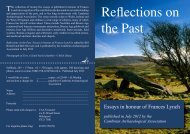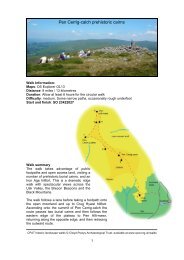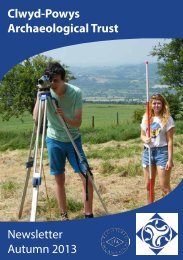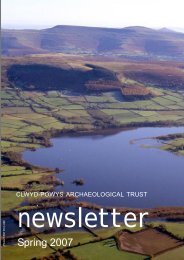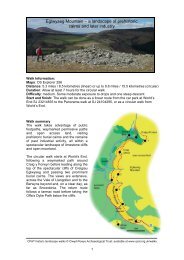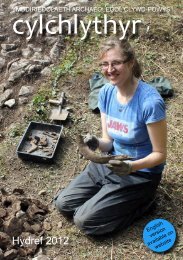Datganiad Cadwraeth Clawdd Offa Offa's Dyke Conservation ...
Datganiad Cadwraeth Clawdd Offa Offa's Dyke Conservation ...
Datganiad Cadwraeth Clawdd Offa Offa's Dyke Conservation ...
Create successful ePaper yourself
Turn your PDF publications into a flip-book with our unique Google optimized e-Paper software.
18 <strong>Datganiad</strong> <strong>Cadwraeth</strong> <strong>Clawdd</strong> <strong>Offa</strong><strong>Offa</strong>'s <strong>Dyke</strong> <strong>Conservation</strong> Statement 18rhyw 200–300 mlynedd yn ddiweddarach.Dealltwriaeth archaeolegol o’r clawdd3.5 Ymddengys bod y cefndir hanesyddol yn nodi cyddestuneglur i Glawdd <strong>Offa</strong> fel ffin diriogaethol ac amddiffynnolrhwng y Mers a theyrnasoedd Prydain i’r gorllewin. Mae’rhenebyn yn dilyn traddodiad o adeiladu cloddiau, ac mae’rffaith iddo gael ei adeiladu efallai yn adlewyrchu methiantrhannol i lywodraethu cymdogion gorllewinol y Mers trwygyfrwng camau milwrol yn unig. Ac eto, mae archwiliadarchaeolegol manwl o’r clawdd yn parhau i godi llawer ogwestiynau yngl~n â’i union natur a swyddogaeth.3.6 Un o’r anawsterau mwyaf amlwg yw nad yw’nymddangos bod y clawdd erioed wedi bod yn wrthglawdd sy’nrhedeg ‘o fôr i fôr’ fel a ddisgrifir gan Asser. Mae ymchwilbarhaus David Hill ers y 1970au wedi methu ag adnabodestyniad gogleddol i’r <strong>Clawdd</strong> heibio’r terfyn ymddangosiadolyn Nhreuddyn (ger Wrecsam). Mae’r bwlch 53 km rhwng BrynRushock (yn Swydd Henffordd) a Redbrook (yn SwyddGaerloyw) yn edrych yn gynyddol ‘wirioneddol’ (o leiaf cynbelled ag y mae absenoldeb arglawdd a ffos barhaus yn ycwestiwn) ac awgrymwyd, hyd yn oed, nad yw’r darn deheuolsy’n sefyll ar ei ben ei hun yn Swydd Gaerloyw yn rhan oGlawdd <strong>Offa</strong> o gwbl (Hill 2000).3.7 Mae manylion eraill <strong>Clawdd</strong> <strong>Offa</strong> hefyd yn ddyrys. Mae’rhenebyn yn dangos amrywiadau sylweddol o ran maint, ffurfstrwythurol a chyfosodiad cymharol yr arglawdd a’r ffos —efallai yn codi cwestiwn yngl~n ag i ba raddau y cafodd eiddylunio yn unffurf i un pwrpas amddiffynnol. At hyn, mae<strong>Clawdd</strong> <strong>Offa</strong> yn unigryw ymhlith gwrthgloddiauEingl-Sacsonaidd gan ei fod yn croesi tirweddau ucheldirynghyd â rhai’r iseldir. Mae’r anghysondeb olaf hwn yn deillioyn rhannol o gyfluniad nad yw’n ymddangos ei fod yn dilynunrhyw egwyddor cynllunio amlwg, er ei fod yn sicr mewnsefyllfa awdurdodol yn wynebu’r gorllewin mewn rhaisectorau. At hynny, mae Frank Noble (1983) wedi dangos bodlleoliad y clawdd yr un mor anghyson mewn perthynas âffiniau diwylliannol tebygol yr 8fed ganrif; mae’r gwrthglawddyn rhedeg trwy ganol trefgorddau Eingl-Sacsonaidd cynharachmewn dull sy’n awgrymu nad marciwr tiriogaethol syml yndangos ffiniau anheddu Seisnig ydoedd.3.8 Mae gwaith cloddio wedi methu â thaflu unrhyw oleuni arolwg gwreiddiol y clawdd. Efallai fod rhai darnau o’r arglawddwedi bod â wyneb gorllewinol a oedd wedi ei rhagfurio yn serthgyda thyweirch, er nad oes unrhyw olion argyhoeddiadol ounrhyw balisâd neu fur cysylltiedig erioed wedi eu canfod, ac maeymdrechion i leoli mynedfeydd gwreiddiol (a ddiffinnir fel bwlchyn y ffos) hyd yma wedi bod yn aflwyddiannus (Hill 1991).Rhywbeth arall sydd yr un mor anodd i’w ddeall yw absenoldebymddangosiadol isadeiledd ehangach sy’n gysylltiedig â’rby <strong>Offa</strong> some 200–300 years later.Archaeological understanding of the dyke3.5 The historical background seems to indicate a clearcontext for <strong>Offa</strong>’s <strong>Dyke</strong> as a territorial and defensiveboundary between Mercia and the British kingdoms to thewest. The monument follows an existing tradition of dykebuilding, and its construction perhaps reflects a partialfailure to dominate Mercia’s western neighbours by directmilitary action alone. Yet detailed archaeologicalexamination of the dyke still raises many questions aboutits exact nature and function.3.6 One of the most obvious difficulties is that the dyke doesnot appear to have ever been the earthwork running ‘from seato sea’ which Asser describes. Sustained research by DavidHill since the 1970s has failed to identify a northern extensionof the <strong>Dyke</strong> beyond its apparent terminus at Treuddyn (nearWrexham), the 53 km gap between Rushock Hill (inHerefordshire) and Redbrook (in Gloucestershire) looksincreasingly ‘real’ (at least as far as the absence of acontinuous bank and ditch is concerned), and it has evenbeen suggested that the isolated southern end of theearthwork in Gloucestershire may not be part of <strong>Offa</strong>’s <strong>Dyke</strong> atall (Hill 2000).3.7 Other details of <strong>Offa</strong>’s <strong>Dyke</strong> are also puzzling. Themonument shows considerable variations in the size,structural form and relative disposition of the bank andditch — perhaps questioning the extent to which it wasuniformly designed for a single defensive purpose. Inaddition, <strong>Offa</strong>’s <strong>Dyke</strong> is unique among comparable Anglo-Saxon earthworks in crossing upland as well as lowlandlandscapes. This latter anomaly partly results in analignment which does not seem to follow any obviousplanning principle, although certainly occupying acommanding west-facing position in some sectors.Moreover, Frank Noble (1983) has demonstrated that thesiting of the dyke is equally inconsistent with respect toprobable 8th-century cultural boundaries; the earthworkruns through the middle of earlier Anglo-Saxon townshipsin a way which suggests it was not a simple territorialmarker at the limits of English settlement.3.8 Excavation has failed to shed clear light on theoriginal appearance of the dyke. Some sections of the bankmay have had the western face steeply revetted with turf,though no convincing traces of any associated palisade orwall have ever been identified, and attempts to locateoriginal entranceways (as defined by a break in the ditch)have so far been unsuccessful (Hill 1991). No easier tounderstand is the apparent absence of wider infrastructurelinked to the earthwork (in stark comparison to an ancient



